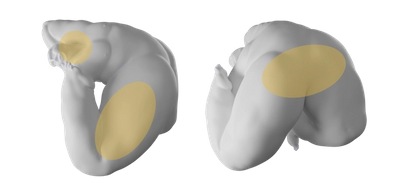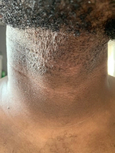Ingrown Hair
in · grown -hehrAn ingrown hair is a trapped hair that's curled back into the skin where it came from, causing a bump.
Also Called
Pseudofolliculitis barbae
Frequently Found On
Legs, pubic area, neck

What is an ingrown hair?
When everything’s going according to plan, the body produces hairs that pop up out of the pores on the skin and everyone goes about their business as usual. But ingrown hairs throw a wrench in that process. Instead of exiting the pore, the hair either curls back into the skin or never fully exits. It can irritate the skin around it and form a bump; you might even see the hair looped underneath the skin.
The ingrown hair “is seen by the skin as a foreign body,” explains Dr. Heidi A. Waldorf, a board-certified dermatologist at Waldorf Dermatology Aesthetics in Nanuet, New York. “The skin doesn’t like it and responds with inflammation. It usually starts red and looks like an acne pimple or cyst, but it can become brown and firm like a scar.” It might also hurt, which is why people tend to want to pick at them, but dermatologists warn against it, because you can accidentally push the hair in further, and risk infection and scarring.
Ingrown hairs are often associated with hair removal—whether shaving, waxing, plucking, electrolysis—because that action interrupts the body’s natural hair production process. They’re especially common among people with curly hair, Black men, and in areas of the body where the hair is coarse and curly, like the pubic area, which makes sense if you think about it: the tight curl of the hair sends it right back in the direction of the pore where it came from.1

What causes ingrown hairs?
Shaving, waxing, and plucking hair are the most common causes of ingrown hairs. Those actions interrupt the function of the skin producing hairs. When we shave/wax/pluck, it seems like the hair has been removed from the area, but beneath the skin, the rest of the hair is still in there, and as it keeps growing, it may curl back, or sideways, into the skin—causing an ingrown hair.
How do you treat ingrown hairs?
An ingrown hair is often trapped underneath recently produced skin, so exfoliating freshly shaved/waxed skin can clear that skin away before it traps any hair, or it can help the ingrown hair break the surface. Dr. Waldorf recommends using cleansers or moisturizers containing chemical exfoliants like alpha or beta hydroxy acids, which gently clear away dead skin cells. “To try to keep hairs from burrowing under the skin,” Dr. Waldorf says, “use a gentle skin brush or even a fresh toothbrush in a flicking motion on the area as you see the hair growing.” But as is always the case with exfoliation, warns Dr. Waldorf, you don’t want to overdo it, which risks drying out, irritating, and disrupting the skin barrier further, leading to even more ingrown hairs. It’s important to moisturize regularly, especially after exfoliating, to avoid dehydrating the skin, but those with ingrown hair-prone skin should avoid super thick creams that might be clogging the pores and making it worse. It’s a delicate balance.
...you might be tempted to pluck the hair out with tweezers, but dermatologists generally don’t recommend it because it increases the possibility of infection or further irritation.
—says Dr. Heidi A. Waldorf, a board-certified dermatologist at Waldorf Dermatology Aesthetics in Nanuet, New York.
If the ingrown hair is painful, says Dr. Waldorf, “treat it with a warm compress for 5-15 minutes, then apply an over-the-counter acne spot treatment with benzoyl peroxide, followed by 1% hydrocortisone cream.” The warm compress should encourage the hair to come to the surface, while the benzoyl peroxide clears dead skin cells and fights bacteria, and the hydrocortisone cream reduces inflammation. At this point, you might be tempted to pluck the hair out with tweezers, but dermatologists generally don’t recommend it because it increases the possibility of infection or further irritation.
After shaving/waxing, applying ingrown hair-targeted topical creams like Tend Skin, which contains anti-inflammatory agents and emollients, as well as hydrocortisone cream (or other over-the-counter steroid creams), can help soothe inflamed and irritated skin. Finding the right combination of treatment will change depending on the person and how prone they are to ingrowns. Talk to your dermatologist if you’re up against stubborn or recurring ingrowns; they’ll have a treatment plan tailored specifically to you.
For the pubic area, there are a lot of ingrown hair treatments available, and their packaging should specify the safest areas of use, but it’s not going to hurt to run the product by your dermatologist or gynecologist over a quick phone call. It’s worth noting that the “pubic area” can have different definitions for people and even just be a euphemism for vulva; the general rule is to never apply a product where it risks entering the body and causing infection, whether it’s ingrown hair treatment or moisturizer.
Mass Index Recommends:

Soft Services
Buffing Bar
$28
net wt 3.75 oz (2)
fragrance free
This is a set of two physical exfoliating bricks for body skin made of fine sanding crystals compressed within a moisturizing, soothing base.

Anthony Logistics
Ingrown Hair Treatment
$34
3 fl oz
chemical exfoliant
Topical gel with glycolic, salicylic and phytic acids, three chemical exfoliants that gently clear away dead skin cells that are either causing—and trapping—ingrown hairs anywhere on the body.

Soft Services
Smoothing Solution
$30
3.3 fl oz
fragrance free
This is a leave-on chemical exfoliant containing 10% AHA to dissolve build-up of dead skin cells and soothing ingredients to calm visible irritation.

Tend
Skin Solution
$17.99
4 fl oz
drugstore standby
Liquid exfoliant that treats and prevents ingrown hairs with isopropyl alcohol to avoid infection, acetylsalicylic acid to clear dead skin, butylene glycol to soothe irritation, and hydrating glycerin.
Soft Services works with experts to review the accuracy of our content, but they do not endorse the products we made.
How do you prevent ingrown hairs?
You could stop shaving/waxing altogether, but that might not be very realistic. Ingrown hair prevention starts with the razor: Use a sharp, new one for best results and shave in the direction hair grows, not against it. Then, follow through with a regimen of exfoliation and moisturizing in the subsequent days after, no matter what mode of hair removal you’re using. Exfoliate with chemical exfoliants, like salicylic acid, glycolic acid, or lactic acid (or anything labeled “AHA” or “BHA”), which come in body washes, scrubs, toners, and lotions. These can help clear away dead skin cells before they get a chance to cover the hair follicle and trap the hair. Moisturizing will keep the skin healthy and hydrated and better primed for the next time you shave.
For men shaving their face, one comprehensive study recommends using electric clippers and skipping the handheld razor altogether because the clippers have a guard that keeps the blade from shaving too close to the skin, which risks the hair regrowing back into the skin.1
Another, more expensive but effective option is laser hair removal, which stops the hair follicle from creating hairs completely.2
Citations
1Pseudofolliculitis barbae; current treatment options by Adebola Ogunbiyi. Clinical, Cosmetic and Investigational Dermatology.
2Treatment of Pseudofolliculitis With a Pulsed Infrared Laser by Arielle N. B. Kauvar, MD. Arch Dermatol.
Additional References:
Keratolytic' properties of benzoyl peroxide and retinoic acid resemble salicylic acid in man by J M Waller, F Dreher, S Behnam, C Ford, C Lee, T Tiet, G D Weinstein, and H I Maibach. Skin Pharmacol Physiol.
Pubic Hair Grooming Prevalence and Motivation Among Women in the United States by Tami S. Rowen, MD, Thomas W. Gaither, Mohannad A. Awad, et al. JAMA Dermatol.
Get Updates
There’s more to come.
Sign up to receive periodical updates on Mass Index, and to be the first to know when Soft Services launches new products. (If we don’t have any updates, we won’t email you.)























